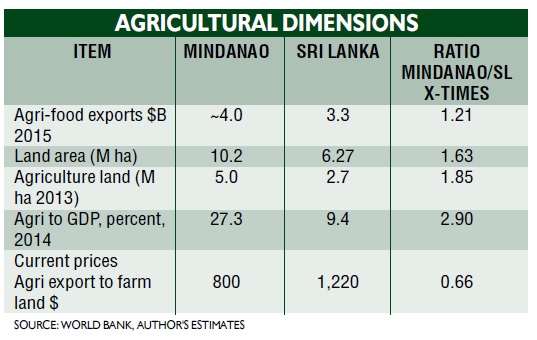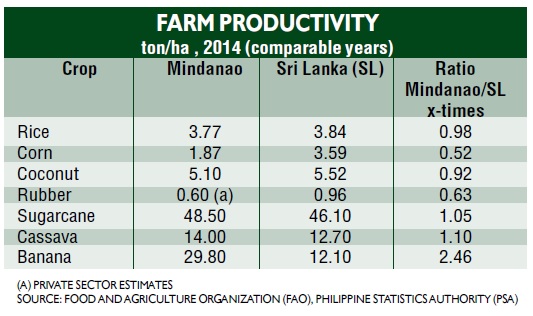Island economies: Mindanao and Sri Lanka
SOME 5,000 kilometers to the west of Mindanao is Sri Lanka. Mindanao has a similar latitude with Sri Lanka at about seven degrees north of the equator. Mindanao’s population in 2015 was about 24 million; Sri Lanka’s, 21 million. Sri Lanka’s land area is 63 percent of Mindanao’s 10.2 million hectares (ha).
Both suffered from internal strife: Mindanao under various shades of insurgency; Sri Lanka under the Tamil Tigers. However, Mindanao’s 41 percent poverty incidence at national headcount in 2012 was very high compared to Sri Lanka’s poverty incidence of only 6.7 percent in 2012.
Economic Dimensions, circa 2013/14
The objective of this brief is to compare Mindanao’s economy with Sri Lanka’s. Some lessons can be learned to move forward Mindanao’s development.
Agriculture
Mindanao’s main crops by harvest area were: coconut, 1.8 million ha; corn, 1.4 million ha; rice, 1.2 million ha; banana, 247,400 ha; rubber, 214,300 ha; sugarcane, 92,500 ha; mango, 76,800 ha; pineapple, 51,200 ha; and oil palm, 42,700 ha in 2014. Three crops dominate agriculture: coconut, 36 percent, corn, 28 percent, and rice, 23 percent.
By contrast, Sri Lanka had 881,000 ha of rice; 395,000 ha of coconut; 222,000 ha of tea; 136,000 ha of rubber; 67,000 ha of maize; 53,000 ha of plantain; 40,000 ha of pepper; 30,000 ha of cinnamon; 24,000 ha of cassava; and 21,000 ha of sugarcane. Only rice is dominant with 32 percent of agriculture land, coconut had 15 percent and rubber 6 percent in 2014.
Comparative Farm Yield
Mindanao lags in most crops, especially corn, coconut and rubber. It is far ahead in bananas, and slightly up in sugarcane and cassava.
Exports
Mindanao’s total exports of $5 billion in 2015 was only half of Sri Lanka’s $10.4 billion in 2015. Mindanao’s agri exports are bigger than Sri Lanka’s: about $4 billion versus $3.3 billion. But in terms of agri-export intensity, i.e., export to agri land, Mindanao is doing only two thirds of Sri Lanka ($800 per ha vs $1,200 per ha). Note: Official export data on Philippine banana are highly understated based on imports of trading countries, such as Japan, China and Korea. Other exports are estimated as actual data are not available.
Mindanao’s principal products in 2015 were banana at about $1 billion, coconut oil, $750 million; nickel ore concentrates, $406 million; preserved fruits, $395 million; nickel mattes and others, $245 million; prepared fish, mainly canned tuna, $203 million; oleo-chemicals, $185 million; fish (chilled or frozen), $211 million; petroleum, $160 million; pineapples, $100 million; copra cake, $70 million; natural rubber, $57 million; activated carbon, $100 million. The rest included: sinter iron ore, banana chips, palm oil, seafood, wood products, abaca pulp and fiber, and coconut products, such as coconut water, coco coir and virgin coconut oil.
Sri Lankan exports are highly diversified. In 2015, the top products were: apparel, $4.548 billion; tea, $1.666 billion; rubber products, $790 million; precious stones, $240 million; electronic equipment, $211 million; optical and medical apparatus, $189 million; fruits, $211 million; mineral fuels, $184 million; fish, $181 million; and machinery, $108 million. Other products above $50 million were vegetable oils, vegetable and fruit preparations, tobacco products, animal feed ingredients, chemical products, vegetable textile fibers, man-made staple fibers, knitted fabrics, toys and games, and aircraft parts. Apparel accounted for about 45 percent.
Tourism
Mindanao’s tourism is still in its “infancy” due to perceived security problems. But it has great potential. By contrast, Sri Lanka had over 1.5 million tourists who generated $2 billion in receipts in 2015.
Benchmarking
Mindanao has much to do. Compared to Sri Lanka, its poverty incidence is six times higher, export at half the level, and agri-export to farm land ratio is only at 66 percent. These weaknesses can be a source of strength with better institutions and social cohesion.
Mindanao policy researchers need to go deeper into the Sri Lanka poverty alleviation success. The Sri Lanka Poverty Assessment found that the fall in poverty stems mostly from increasing labor incomes as the economy has shifted from less productive agriculture towards the industry and service sectors, more urbanization, and rising domestic demand (World Bank 2016).
Mindanao must diversify its economy in order to create jobs and reduce mass poverty. It must bring investors in agriculture, aquaculture, food manufacturing and non-agri manufacturing, and promote tourism.
A noted political economist, Fermin Adriano, traces Mindanao’s under-development to “imperial Manila,” that is the highly centralized allocation of resources and decision-making. The region has better prospects now under the Duterte Presidency.
(The article reflects the personal opinion of the author and does not reflect the official stand of the Management Association of the Philippines or MAP. The author is the Vice Chair of the MAP AgriBusiness and Countryside Development Committee, and the Executive Director of the Center for Food and AgriBusiness of the University of Asia & the Pacific. Feedback at <map@map.org.ph> and <rdyster@gmail.com>. For previous articles, please visit )


